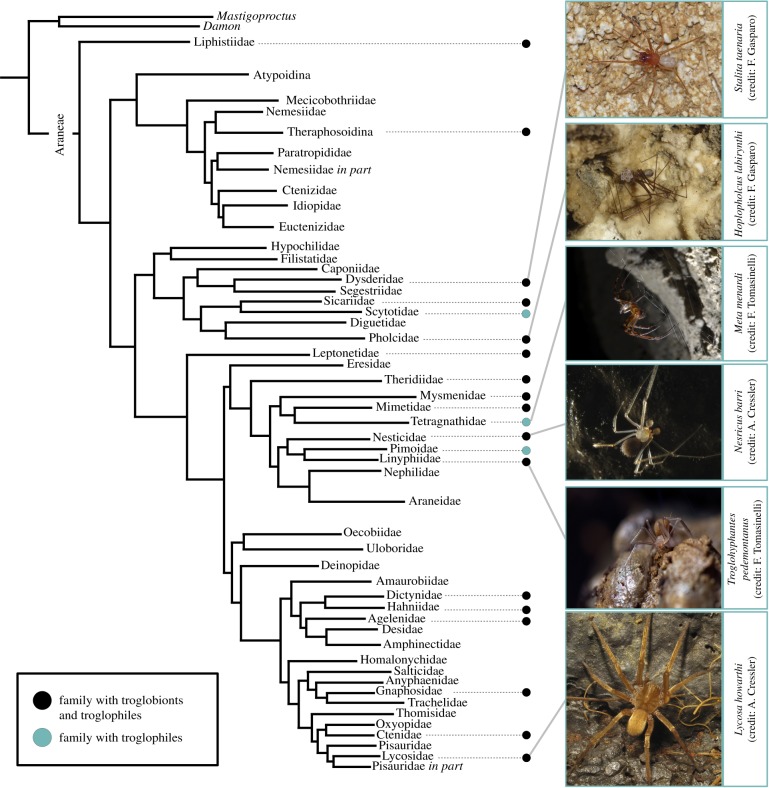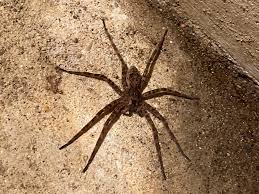Are cave spiders harmful?
Cave spiders feed on smaller invertebrates, most frequently myriapods and slugs. The European cave spider is not dangerous to humans and although (in common with nearly all spiders) they have venom, its effect on large mammals is negligible.
Cave spiders are venomous, but their bites are not usually dangerous to humans. These spiders can be found in dark, damp environments like caves, tunnels, and basements. While they may look intimidating with their long legs and multiple eyes, cave spiders are generally not aggressive towards humans and will only bite if they feel threatened. Their venom is not as potent as other spider species, such as the black widow or brown recluse.

Cave spider bites can cause localized pain, redness, and swelling, similar to a bee sting. In rare cases, some individuals may experience an allergic reaction to the venom. If a person is bitten by a cave spider and experiences severe symptoms like difficulty breathing or extreme pain, they should seek medical attention immediately. However, most bites can be treated at home with basic first aid and monitoring for any signs of infection.
What kind of spiders are in caves?
The description of the first troglobiont spider dates back to 1847, when Schiödte (1812–1884) described Stalita taenaria (Dysderidae) from the Postojna cave in Slovenia. S. taenaria shows remarkable troglobiomorphic traits, namely the absence of eyes—‘oculi nulli’—and a pronounced cuticular depigmentation—‘abdomine niveo’ .

The discovery of a spider showing extraordinary adaptations to the subterranean environment, paved the way for future generations of scientists to disclose the huge biological diversity hidden in subterranean habitats around the world.

According to available estimates, around 1000 troglobiomorphic spiders have been classified as troglobionts. In addition, a countless number of species have been reported to be associated with caves. During our bibliographic survey, we recorded spiders showing subterranean adaptations in at least 48 families (table 1)—out of the 113 currently listed.
List of the spider families including troglobiont/troglophile species.
| family | distribution | notes |
|---|---|---|
| ORTOGNATHA | ||
| Barychelidae | Cuba, Dominican Republic | troglobionts in Troglothele and Trichopelma |
| Cyrtaucheniidae | Guinea | Acontius stercoricola is the only troglobiont in the family |
| Dipluridae Hexatelidae | Central and South America, Philippines, Australia New Zealand | troglophiles and troglobionts in Euargus, Harmonicon, Masteria and Troglodiplura Hexathele cavernicola is the only troglobiont in the family |
| Liphistiidae | Malaysia, Thailand | troglobionts in Liphistius |
| Microstigmatidae | Ecuador | Spelocteniza ashmolei is the only troglobiont in the family |
| Theraphosidae | Mexico, Brazil | troglobionts in Tmesiphantes and Hemirrhagus |
| LABIDOGNATHA | ||
| Agelenidae | Europe, USA, China | various troglobiomorphic genera (e.g. Coelotes, Histopona, Draconarius) |
| Amaurobiidae | Europe | some troglophiles in Amaurobius |
| Anapidae | South Africa, Korea | troglobionts in Crozetulus and Conculus |
| Austrochilidae | Tasmania | Hickmania troglodytes is the only troglophile in the family |
| Ctenidae | Dominican Republic, Java, Cuba, Australia, South Africa | troglobionts in Ciba and Janusia |
| Cybaeidae | Holartic | troglobionts in Cybaeus and Cybaeozyga |
| Cycloctenidae | Australia, Tasmania | troglobionts in Cycloctenus and Toxopsiella |
| Dyctinidae | Europe, USA, Mexico, Japan | troglobionts in Cicurina |
| Dysderidae | Mediterranean basin, Canary Islands | various degree of adaptation in several genera |
| Gnaphosidae Grandungulidae | Cuba, southeast Asia Australia, New Zealand | troglobionts in Herpyllus, Hongkongia and Micythus cave-dwelling species in various genera |
| Hahniidae | Europe | troglobionts in Hanhia, Iberina |
| Holarchaeidae | Tasmania and New Zealand | cave-dwelling species in Holarchaea |
| Leptonetidae | Holartic, Mexico, South America | numerous troglobionts and troglophiles |
| Linyphiidae | Holartic, Africa, Australia, Central America | numerous troglobionts and troglophiles |
| Liocranidae | Europe, North Africa, Canary Islands | cave-dwelling species in Brachyanillus, Liocranum and Agraecina |
| Lycosidae | Hawaii, French Polinesia | three troglobitic species in Adelocosa, Lycosa and Nukuhiva |
| Mimetidae | Sri Lanka | Mimetus strinatii is the only troglobiont in the family |
| Mysmenidae | Mexico, Tasmania, China (?) | troglobionts in Maymena and Trogloneta |
| Nesticidae | Holartic, Brazil, Africa, Oceania | numerous troglobionts and troglophiles |
| Ochyroceratidae | North and South America, Antilles, Asia, Africa | cave-dwelling species in several genera |
| Oonopidae | Mexico, Cuba, China, Ecuador, India, Iran | troglobionts in several genera (e.g. Dysderoides, Gamasomorpha, Wanops) |
| Orsolobidae | New Zealand | Anopsolobus subterraneus is the only troglobiont in the family |
| Pholcidae | Northern and Southern Hemispheres | numerous troglobiomorphic species |
| Phyxelididae | South Africa | cave-associated species and one troglobiont (Phyxelida makapanensis) |
| Pimoidae | Holartic | troglophiles especially in Pimoa |
| Prodidomidae | Galápagos Islands, Brazil | troglobiont in Lygromma |
| Scytotidae | Philippines | cave-associated species in Scytodes |
| Sicariidae Sparassidae | Africa, South America Asia, East Africa | cave-associated species and few troglobionts in Loxosceles troglobiomorphic species in Sinopoda and Berlandia |
| Stiphidiidae | Australia, Tasmania | troglobionts in several genera (e.g. Baiami, Stiphidion, Tartarus) |
| Symphytognathidae | Australia, Europe (Portugal) | troglobionts in Anapistula |
| Synotaxidae | Tasmania | species with troglobiomorphic traits in Tupua |
| Telemidae | North-Central America, Europe, Asia, South Africa | troglobionts in several genera (e.g. Apneumonella, Telema, Telemofila, Usofila) |
| Tetrablemmidae | Mexico, China, Japan, Sumatra | numerous troglophiles |
| Tetragnathidae | Holartic, Tasmania | troglophiles in Meta, Metellina, Okileucauge and Orsinome |
| Theridiidae | USA, Oceania, Europe, Galápagos Islands | troglophiles and troglobionts in various genera |
| Theridiosomatidae | Venezuela, Sri Lanka | cave-dwelling species, especially in Plato |
| Trochanteridae | Oceania | troglobionts in Desognanops and Olin |
| Trogloraptoridae | caves in Oregon (northwest USA) | monospecific family (Trogloraptor marchingtoni, troglophile) |
| Zoropsidae | Oregon (USA) | troglobionts in Phanotea and Tengella |
How big is a cave spider?cave spiders size
The European Cave Spider, Meta menardi, is one of the UK’s largest spiders with a bulky, round, oval body around 10-13mm for males and 12-17mm in length for females, with a leg-span of around 5cm . Sometimes larger specimens can be found.Visitors to the magnificent Marakoopa Cave and the Hastings Caves in Tasmania are generally unnerved when told of the size of Cave Spiders-while the body is just 2 centimetres in length, the leg-span can be up to 18 centimetres .
Carrai Cave Spider
The Carrai Cave Spider is important because it has helped to establish the idea that all araneomorph spiders have evolved from web building ancestors.
Gradungulidae is one of the few araneomorph families with two pairs of book lungs. Progradungula carraiensis is recognised by the presence of enlarged front tarsal claws and by making small but unique prey catching webs, it is only known from the Carrai Plateau in northern New South Wales. The spiders are a glossy fawn brown in colour, somewhat darker on the head and jaws region. The abdomen has several light grey chevron markings, the legs are long and slender.

Where do Carrai Cave Spiders live?
Habitat
These spiders are found in the limestone caves of the Carrai Plateau, although they probably also occur among rocks and tree trunks on the surface. In caves their webs are usually seen around entrance regions or areas where bat guano is deposited. Such sites are high energy zones where food animals like beetles, flies, moths and crickets are plentiful.
Distribution
The Carrai Cave Spider is known only from the moist forests of the Carrai Plateau in northern New South Wales. A second species of Progradungula, P. otwayensis, occurs in Victoria.
Spiders of the family Gradungulidae are found only in eastern Australia and New Zealand. The giant Tasmanian Cave Spider Hickmania troglodytes was recently transferred to the same family. The closest relatives of the group live in South America. These spiders are relics of ancient gondwanan faunas.
What do Carrai Cave Spiders eat and how do they mate?
Feeding and diet
Beetles, flies, moths and crickets are the main prey of the Carrai Cave Spider. The web and the prey catching behaviour of these spiders is unusual. An upper network of threads attached to the rock walls supports a small (about 25 by 6 mm), slanting, ladder-like platform of cribellate catching silk just above the ground, to which it is guyed down by two parallel, supporting, silk lines.
Cribellate silk comes from a specialised, flattened silk spinning organ called the cribellum which has thousands of tiny silk producing spigots. Each cribellate silk thread is made up of thousands of very fine silk fibrils that are drawn from the cribellum by the calamistrum, a row of bristles on the last legs. Webs made from this type of catching silk are efficient tanglers of prey. The spider positions itself head down on the platform so that its extended front legs with their enlarged claws are just above the ground. The legs, sensory hairs and slit organs monitor web and air vibrations caused by prey animals walking below.
When a moth or beetle wanders within range, the spider lunges quickly downwards with its hooked legs and scoops the victim up onto the cribellate silk platform. The clinging cribellate silk wraps itself around the struggling prey, helping to hold it as the spider clasps and bites it. The enlarged claws on the front legs, which evolved as part of this web-based prey catching strategy, have been retained for prey grasping in the many ground dwelling, webless relatives of Progradungula.
Evolutionary relationships
This species is important as the first web builder to be discovered within a family of basal araneomorph hunting spiders (“basal” because they retain “primitive” features not present in more “advanced” families). This helped to establish the idea that all araneomorph spiders have evolved from web building ancestors.
